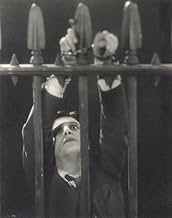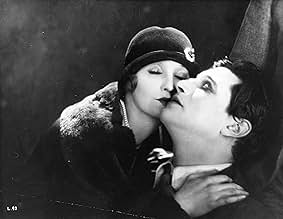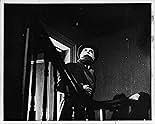IMDb-BEWERTUNG
7,3/10
14.459
IHRE BEWERTUNG
Eine Vermieterin vermutet, dass ihr neuer Untermieter der Verrückte ist, der in London Frauen tötet.Eine Vermieterin vermutet, dass ihr neuer Untermieter der Verrückte ist, der in London Frauen tötet.Eine Vermieterin vermutet, dass ihr neuer Untermieter der Verrückte ist, der in London Frauen tötet.
June Tripp
- Daisy - A Mannequin
- (as June)
Wallace Bosco
- Pub Customer
- (Nicht genannt)
Daisy Campbell
- Mother
- (Nicht genannt)
Maudie Dunham
- First Victim
- (Nicht genannt)
Reginald Gardiner
- Dancer at Ball
- (Nicht genannt)
Eve Gray
- Showgirl Victim
- (Nicht genannt)
Alfred Hitchcock
- Extra in Newspaper Office
- (Nicht genannt)
Alma Reville
- Woman Listening to Wireless
- (Nicht genannt)
Empfohlene Bewertungen
it is a real special film. first - for the status of early Hitchcock. the second - for Ivor Novello performance who seems be more than a good one but the right piece for the balance of film. the story is predictable and this fact did it charming. because old themes are mixed with smart images. because the romanticism and the touching scenes reminds the popular literature of XIX century. because it is fresh and naive and seductive and dark. and because it is a fascinating clue for discover the art of its director in new and interesting perspective.
A story loosely based on Jack the Ripper. In London a killer called the Avenger goes around killing blond-haired girls. Around this time Mr. and Mrs. Bunting take in a lodger (Ivor Novello). He's quiet but very odd. He takes a liking to their blond-haired daughter Daisy (June Tripp). But then the Buntings begin to suspect that he may be the Avenger and want Daisy as his next victim...
Hitchcock's first thriller and a very good one. Very few title cards are used--he uses images to carry the film. Sometimes it works but, more than once, I was confused. It was one of his first films though so this can be forgiven. It also moves a bit too slow. But it's still worth seeing.
You can see the beginnings of his later work peeking through and there are some sequences so well directed that they're stunning (the one where Novello and Tripp kiss is just SO beautiful). Also the acting is actually quite good by everybody--especially Novello. He was a box office draw in the 1920s and it's easy to see why. The man is not only a good actor he was undeniably beautiful. It's easy to see why he was once called one of the most beautiful men alive.
Novello was gay--I wonder if Hitch knew that. There are two lines in this film where people talk about his character--"Good thing he doesn't like girls" and "Even if he is a bit queer". These lines are quite interesting now--I wonder if they were put in on purpose or just happened to be written without anyone knowing. Interesting to think about...
Hitchcock's first thriller and a very good one. Very few title cards are used--he uses images to carry the film. Sometimes it works but, more than once, I was confused. It was one of his first films though so this can be forgiven. It also moves a bit too slow. But it's still worth seeing.
You can see the beginnings of his later work peeking through and there are some sequences so well directed that they're stunning (the one where Novello and Tripp kiss is just SO beautiful). Also the acting is actually quite good by everybody--especially Novello. He was a box office draw in the 1920s and it's easy to see why. The man is not only a good actor he was undeniably beautiful. It's easy to see why he was once called one of the most beautiful men alive.
Novello was gay--I wonder if Hitch knew that. There are two lines in this film where people talk about his character--"Good thing he doesn't like girls" and "Even if he is a bit queer". These lines are quite interesting now--I wonder if they were put in on purpose or just happened to be written without anyone knowing. Interesting to think about...
The Lodger was the feature which Hitchcock himself described as his first true film (it was actually his third complete one), and film historians, particularly auteurists tend to focus upon it because it is it introduces themes of murder and suspense that Hitch's name would later be synonymous with.
To be honest, the first thing that strikes me upon watching The Lodger is its sense of rhythm. Hitchcock's earliest films were always very rhythmic and the opening moments of The Lodger are a great example, with a dynamic and attention grabbing sequence of shots and title cards. Much of this however may be down to the style of the seldom referenced screenwriter Eliot Stannard, who has a credit on all but one of Hitchcock's silents. Stannard was a master at telling stories in purely visual terms, and his screenplays often go as far as to map out series of interlocking images.
The next very obvious thing about The Lodger is that right from the start Hitchcock was more interested in cinematic technique than he was in performances or artistry. The Lodger is crammed with Expressionist effects, in particular double exposures. Hitch clearly hadn't learnt the art of subtlety yet and these are massively overused. We can also tell early on that Hitchcock was interested in using his camera to involve the audience in the film, throwing in point-of-view shots or drawing our attention to specific items. In this regard his technique was not yet refined. He was develop it in his later silents.
Of course what generally interests followers of Hitchcock's career is the fact that The Lodger is the first time he deals with the grisly subject of murder. It's true that there are many Hitchcockian elements here murder, blondes, a love triangle and even a MacGuffin in the form of the Avenger whom all the characters are concerned about but isn't the focus of the story. There is a kind of morbid sensationalism concerning the killings, something we'd see right through to the other end of Hitch's career with the comment about "ripped whores" in 1972's Frenzy. There's also of course a "wrong man", although here he appears more as the subject of a whodunit. The later Hitchcock would have focused upon the plight of the wrongly accused, and made a more suspenseful film in the process.
All in all, The Lodger isn't really as significant an early Hitchcock as some would believe. For one thing there is the influence of screenwriter Stannard and the fact that Hitchcock, although he may have relished the material, was still very young and inexperienced. The fact is The Lodger may contain more of Stannard's influence than it does Hitchcock's. It's not as if Hitchcock immediately began making more murder thrillers. The majority of his British thrillers are of the espionage/adventure variety, and it would take up until the early 40s for Hitchcock to really begin making masterpieces in the domestic murder genre. It's also nowhere near being Hitch's best silent film, even though it tends to be remembered over more polished works like The Ring and The Manxman. Taken out of context though, it is a fairly decent late silent thriller, with only a few minor flaws in plot and direction.
To be honest, the first thing that strikes me upon watching The Lodger is its sense of rhythm. Hitchcock's earliest films were always very rhythmic and the opening moments of The Lodger are a great example, with a dynamic and attention grabbing sequence of shots and title cards. Much of this however may be down to the style of the seldom referenced screenwriter Eliot Stannard, who has a credit on all but one of Hitchcock's silents. Stannard was a master at telling stories in purely visual terms, and his screenplays often go as far as to map out series of interlocking images.
The next very obvious thing about The Lodger is that right from the start Hitchcock was more interested in cinematic technique than he was in performances or artistry. The Lodger is crammed with Expressionist effects, in particular double exposures. Hitch clearly hadn't learnt the art of subtlety yet and these are massively overused. We can also tell early on that Hitchcock was interested in using his camera to involve the audience in the film, throwing in point-of-view shots or drawing our attention to specific items. In this regard his technique was not yet refined. He was develop it in his later silents.
Of course what generally interests followers of Hitchcock's career is the fact that The Lodger is the first time he deals with the grisly subject of murder. It's true that there are many Hitchcockian elements here murder, blondes, a love triangle and even a MacGuffin in the form of the Avenger whom all the characters are concerned about but isn't the focus of the story. There is a kind of morbid sensationalism concerning the killings, something we'd see right through to the other end of Hitch's career with the comment about "ripped whores" in 1972's Frenzy. There's also of course a "wrong man", although here he appears more as the subject of a whodunit. The later Hitchcock would have focused upon the plight of the wrongly accused, and made a more suspenseful film in the process.
All in all, The Lodger isn't really as significant an early Hitchcock as some would believe. For one thing there is the influence of screenwriter Stannard and the fact that Hitchcock, although he may have relished the material, was still very young and inexperienced. The fact is The Lodger may contain more of Stannard's influence than it does Hitchcock's. It's not as if Hitchcock immediately began making more murder thrillers. The majority of his British thrillers are of the espionage/adventure variety, and it would take up until the early 40s for Hitchcock to really begin making masterpieces in the domestic murder genre. It's also nowhere near being Hitch's best silent film, even though it tends to be remembered over more polished works like The Ring and The Manxman. Taken out of context though, it is a fairly decent late silent thriller, with only a few minor flaws in plot and direction.
This is the first real Hitchcock movie. The one in which he really starts to use all his abilities, although we can see that they are still not mature yet. It's very interesting because he makes a lot of experiments in this film, like the glass ceiling, and we see how hard he wanted, at the time, to really make his mark, to stand above the rest. Although the ending is not very good, the first 20 minutes of The Lodger are impressive, with Hitchcock slowly telling us (visually, of course) about the killer and his particularities, until the arrival of Ivor Novello. A must-see picture to any real Hitchcock fan
In a quiet British town, a serial killer known as The Avenger is on the loose. Noted for his partiality for blondes, The Avenger has killed seven women-and shows no signs of stopping.
Ivor Novello, as the title character, is a quiet and mysterious man who appears at a boarding house soon after the seventh murder is committed. The landlady reluctantly allows him to stay in an upstairs room, but becomes suspicious when she notices the young man turning over all the portraits of blonde-haired women in his room. It doesn't help the landlady's suspicions when the man begins showing an interest in her daughter, Daisy (naturally, a blonde). Daisy's boyfriend, a detective, is assigned to The Avenger's case, and (almost immediately) becomes suspicious of the lodger as well.
Although The Lodger isn't Hitchcock's first feature, it most certainly is the film that launched his career as the "Master of Suspense." Noticeable Hitchcock trademarks are apparent here-namely the lodger's arrival and the ceiling/mirror scene.
Loosely based on the infamous serial killer Jack the Ripper, this silent thriller is fast-paced with exceptional performances. The score, at times, seems out of place, but Hitchcock fans will nonetheless enjoy this film.
Ivor Novello, as the title character, is a quiet and mysterious man who appears at a boarding house soon after the seventh murder is committed. The landlady reluctantly allows him to stay in an upstairs room, but becomes suspicious when she notices the young man turning over all the portraits of blonde-haired women in his room. It doesn't help the landlady's suspicions when the man begins showing an interest in her daughter, Daisy (naturally, a blonde). Daisy's boyfriend, a detective, is assigned to The Avenger's case, and (almost immediately) becomes suspicious of the lodger as well.
Although The Lodger isn't Hitchcock's first feature, it most certainly is the film that launched his career as the "Master of Suspense." Noticeable Hitchcock trademarks are apparent here-namely the lodger's arrival and the ceiling/mirror scene.
Loosely based on the infamous serial killer Jack the Ripper, this silent thriller is fast-paced with exceptional performances. The score, at times, seems out of place, but Hitchcock fans will nonetheless enjoy this film.
Wusstest du schon
- WissenswertesFor the opening of this movie, Sir Alfred Hitchcock wanted to show the Avenger's murder victim being dragged out of the Thames River at night with the Charing Cross Bridge in the background, but Scotland Yard refused his request to film at the bridge. Hitchcock repeated his request several times, until Scotland Yard notified him that they would "look the other way" if he could do the filming in one night. Hitchcock quickly sent his cameras and actors out to Charing Cross Bridge to film the scene, but when the rushes came back from the developers, the scene at the bridge was nowhere to be found. Hitchcock and his assistants searched through the prints, but could not find it. Finally, Hitchcock discovered that his cameraman had forgotten to put the lens on the camera before filming the night scene.
- PatzerWhen The Lodger (Ivor Novello) and Daisy (June Tripp) are playing chess, but the board is set up inappropriately. The square in the right corner should always be white. In this case, the bottom-right square is dark (black). This is the most obvious when The Lodger (Ivor Novello) is poking the coals in the fireplace.
- Zitate
Joe Betts: Does this lodger of yours mean any harm to Daisy?
The Landlady: Don't be silly, Joe. He's not that sort. Even if he's a bit queer, he's a gentleman.
- Crazy CreditsClosing credits: Thank you to everyone who supported the BFI's Silent Hitchcock restoration project.
- Alternative VersionenThe original version of The Lodger directed by Alfred Hitchcock in 1926 was restored in 1999 in honor of the directors 100th anniversary. The film was restored by the British National Film & TV Archives and a new score by Ashley Irwin was commissioned by ZDF/ARTE (Germany) and premiered on August 13, 1999 (what would have been Hitchcock's 100th birthday).
- VerbindungenEdited into Geschichte(n) des Kinos: Une vague nouvelle (1999)
Top-Auswahl
Melde dich zum Bewerten an und greife auf die Watchlist für personalisierte Empfehlungen zu.
Details
- Erscheinungsdatum
- Herkunftsland
- Sprache
- Auch bekannt als
- Der Mieter
- Drehorte
- Produktionsfirmen
- Weitere beteiligte Unternehmen bei IMDbPro anzeigen
Box Office
- Budget
- 12.000 £ (geschätzt)
- Weltweiter Bruttoertrag
- 83.568 $
- Laufzeit
- 1 Std. 32 Min.(92 min)
- Farbe
- Sound-Mix
- Seitenverhältnis
- 1.33 : 1
Zu dieser Seite beitragen
Bearbeitung vorschlagen oder fehlenden Inhalt hinzufügen




























